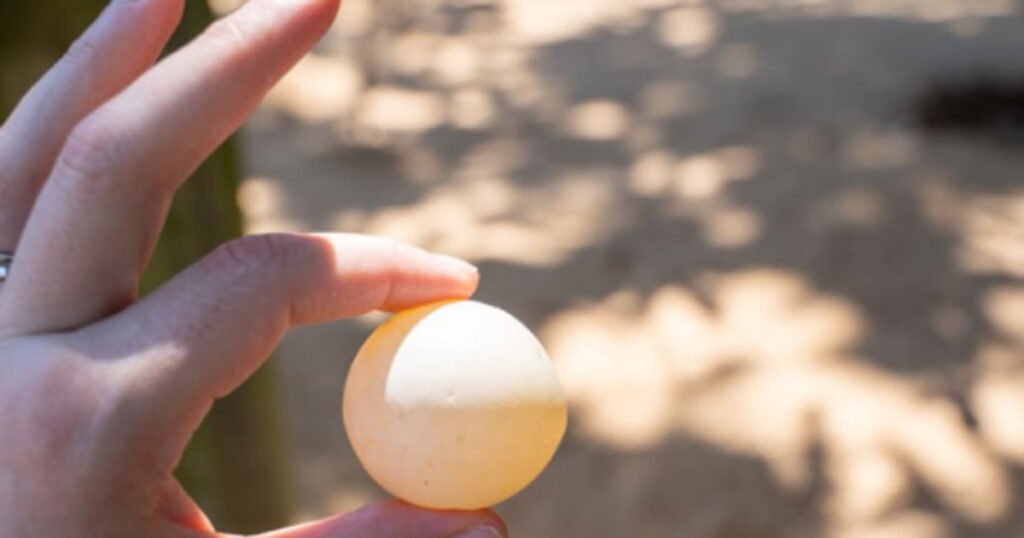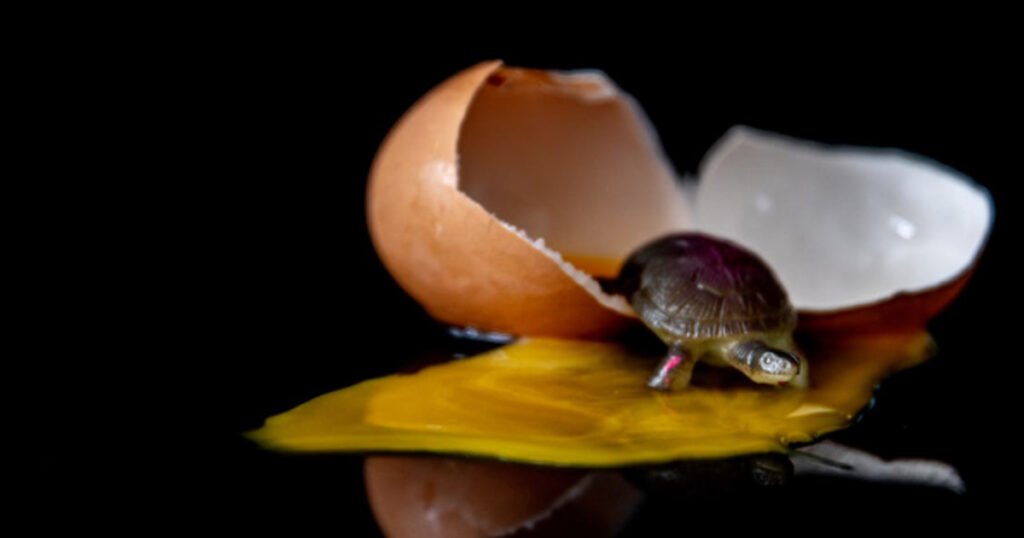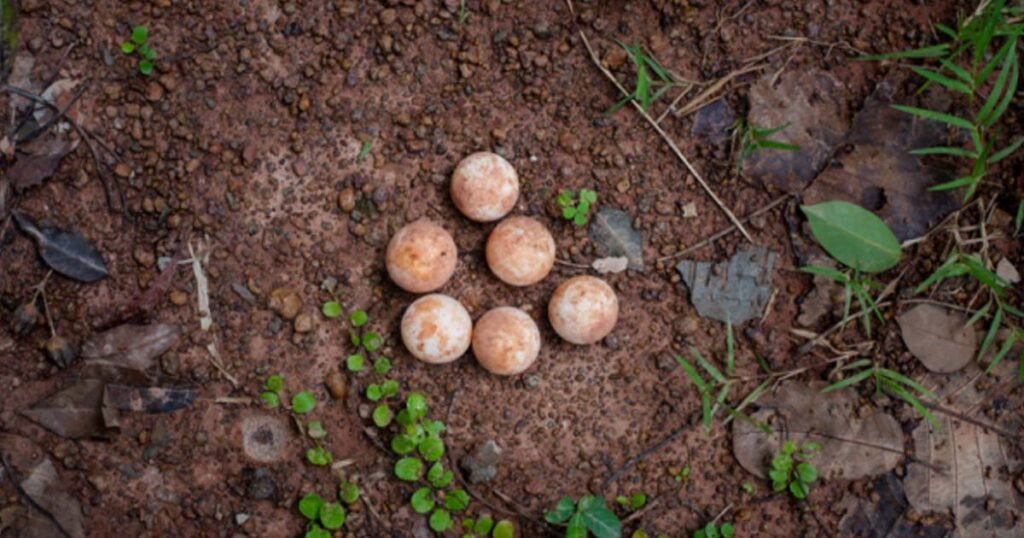If you’re interested in turtles, you might already know that they lay eggs as part of their reproductive process. But have you ever wondered, “How big are turtle eggs?” Turtles, like many other reptile species, rely on eggs for reproduction. This reproductive strategy is known as oviparity. As reptiles, turtles follow this pattern and lay their eggs in carefully chosen places. They can incubate safely on sandy beaches or soil.
It is common among reptiles, with eggs typically laid in a nest or burrow. However, not all turtle species’ egg sizes are the same; they depend on the species. But, the size difference is not so significant even but the pattern can be different a bit. In this article, we’ll talk about turtle eggs, “How big are turtle eggs?” breeding seasons, and other intriguing details.
Table of Contents
How Big Are Turtle Eggs?

Turtle eggs come in various sizes, depending on the species. Commonly, turtles’ eggs look like ping-pong balls sized.
Variability in Egg Sizes
Loggerhead turtle eggs, for instance, are medium-sized, about 4.0 cm in diameter and 36 g in weight. Other species, like the Hawksbill turtle, have smaller eggs at 3.8 cm in diameter and approximately 28 g in weight. Leatherback turtle eggs, on the other hand, are larger, averaging 5.3 cm in diameter and weighing 90 g.
Egg sizes may vary within the same species. For instance, Olive Ridley turtle eggs can be slightly under 2 inches in diameter and weigh between 12 and 22 grams each. Red Ear Slider turtle eggs measure between 1 to 1.5 inches long and weigh between 6.1 to 15.4 grams.
Others, like the eastern box turtle and the painted turtle, produce more elongated ones. Additionally, turtles’ egg shells are leathery and flexible, unlike the hard-shelled eggs of birds.
How Big Are Sea Turtle Eggs?
Sea turtle eggs come in various sizes depending on the species. For example, loggerhead sea turtle eggs are the size of ping-pong balls. Leatherback sea turtles lay the largest eggs, noticeably bigger than any other species. Green sea turtles lay slightly larger eggs, while Kemp’s ridley sea turtles lay slightly smaller ones.
If you haven’t heard about Kemp’s ridley sea turtles, they are one of the smallest and most endangered sea turtle species. They are named after Richard Kemp, who described the species in 1880.
Differences in Size
There can be significant differences in egg size even within the same nesting area. Leatherback eggs, for instance, are approximately 8 mm larger than green turtle eggs. Hawksbill sea turtles lay some of the smallest eggs among sea turtles.
Incubation period
During the incubation period, which lasts 50 to 60 days, sea turtle eggs usually stay in the nest. However, eggs can sometimes be disturbed by predators or washed away by the tides.
Avoiding is Most Suitable for Preservation
If a sea turtle egg becomes exposed, it’s crucial to avoid disturbing it to give it the maximum chance of survival. Leaving the egg undisturbed allows it to continue its natural incubation process.
How Big Are Box Turtle Eggs?

Eastern box turtle eggs vary in size and shape, with some being elongated and others more rounded. It is fascinating to observe the differences in egg size and shape among individual turtles. Some eggs may be as long as 4 cm, while others are just over 2 cm in length. This variability reflects each female turtle’s unique characteristics.
Eastern Box Turtles Egg Structure
Eastern box turtle eggs differ from sea turtle eggs in their texture and composition. Unlike leathery sea turtle eggs, box turtle eggs take time to harden after being laid.
Calcium Coating Process: After being laid, Eastern box turtle eggs undergo a process known as “chalking,” where a thin calcium layer on the outside of the egg gradually hardens. This process supports the eggshell.
Retained Flexibility: Even after chalking, Eastern box turtle eggs retain flexibility due to the thinness of the calcium layer. This flexibility allows the eggs to withstand minor pressure without breaking.
Natural Dentures: During the nesting process, the female box turtle often dents some of the eggs. However, these dents are typically temporary and naturally return to their original shape over time.
While Eastern box turtle eggs may seem fragile, their natural flexibility and protective shell help protect the developing baby turtles from harm. This resilience is essential for the species’ survival.
How Many Eggs Turtles Lay At A Time Or Clutch?

A group of turtle eggs, known as a clutch, varies in number. Turtle clutches, which are a collection of turtle eggs laid together in a nest, vary in size depending on the species.
Sea Turtles
Sea turtles lay multiple clutches of eggs during nesting season. The number of eggs in each clutch varies depending on the species. For instance, green turtles can lay up to 12 nests in a single season, each containing 80-180 eggs. Leatherback turtles, the largest sea turtles, lay around 110 eggs per clutch. On the other hand, Hawksbill turtles produce the largest clutches, with up to 140-160 eggs in a nest.
River Terrapins
River-dwelling turtles, like Terrapins, have their own unique nesting habits. They move along rivers in search of suitable nesting sites, usually large sandbars. Mating happens from November to December, and egg-laying happens from late January to mid-March. Each season, female Terrapins typically lay about 25-35 eggs, with some recorded clutches containing 42 or 43 eggs.
Tortoises
Unlike sea turtles and river terrapins, tortoises show different nesting behaviors. They select suitable nest sites, preferring locations with ample sunlight and well-drained soil for incubation. After mating, which can result in fertilization of up to 30 eggs, tortoises lay their eggs in separate clutches. These clutches typically contain two to twelve eggs each, depending on the species, allowing for each clutch’s development one at a time.
The nesting habits of turtles and tortoises are diverse and fascinating, from laying multiple clutches to searching for sandbars.
Some Interesting Facts About Turtles Eggs
- Turtles do not protect their eggs once they lay them, leaving the hatchlings to fend for themselves.
- Eastern box turtles, like many reptiles, have no sex chromosomes; gender is determined by temperature during incubation.
- Red Ear Slider turtle eggs can vary in size and may hatch after 50 to 65 days of incubation.
- Incubation time varies among turtle species; for example, Olive Ridley sea turtle eggs take 45 to 65 days to hatch.
- The size of turtle eggs varies based on the species; for instance, Olive Ridley eggs are under 2 inches in diameter.
- A large hen’s egg, for comparison, weighs about 57 grams and is over 2 inches long.
- Turtles’ eggs are always buried for incubation, providing some level of protection during development.
FAQ
How big are snapping turtle eggs?
Snapping turtle eggs are relatively small, similar in size to ping pong balls. When the hatchlings emerge, they measure about an inch in length.
How big are painted turtle eggs?
Painted Turtle eggs are about 31 millimeters long, or roughly 1.2 inches. These eggs have a smooth, white surface and are oval-shaped.
Read More: Does Turtles Have Backbones
Final Thought
Our exploration of the question “How big turtle eggs are” gives us fascinating insight into these fascinating creatures’ reproductive processes. From the tiny Olive Ridley eggs to the comparatively large Leatherback eggs, turtle eggs’ size reflects the species’ variety. Whether buried in the sand or nestled in a nest, turtle eggs play a crucial role in the survival of these ancient reptiles. As we look at nature’s wonders, turtle eggs remind us of the delicate balance maintained in their ecosystems.
